Well, we just got back from one of the best trips we’ve taken. The French Alps are truly spectacular. We went to Chamonix Mont Blanc to spend the weekend skiing and playing in the snow.
We went skiing the first day. Unfortunately the weather across Europe has been very warm, so the snow wasn’t the best. Nonetheless, it was great to be back on the slopes.
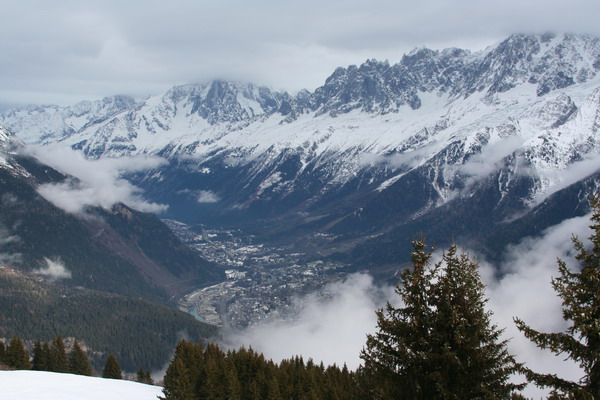
The next day, the sun came out and it was a beautiful (and warm) day.
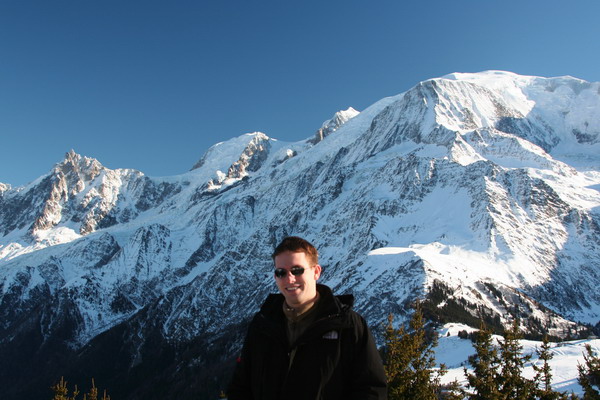
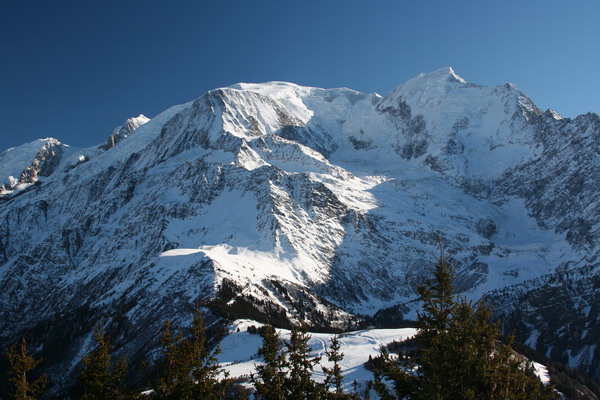
We loved snowshoeing on the mid mountain (around 1800m)…
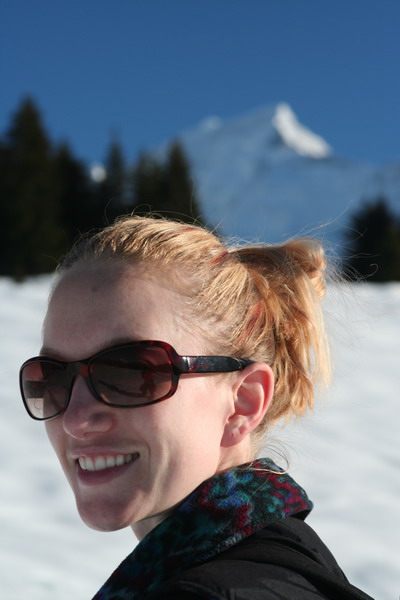
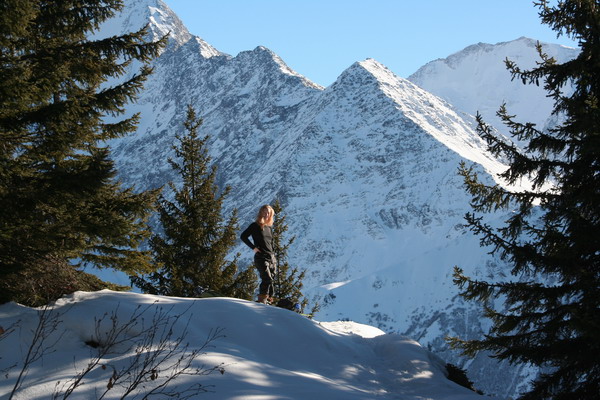
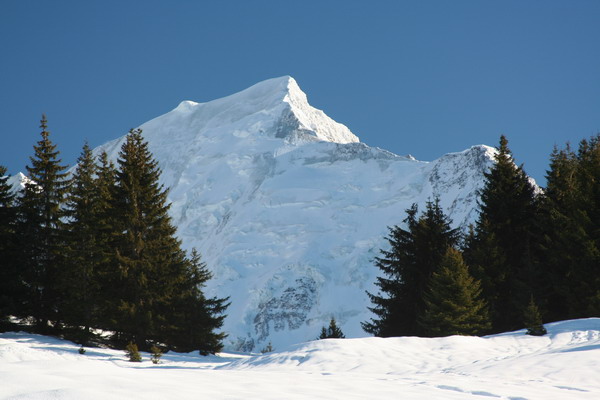
The sun lit up the mountains real nice…
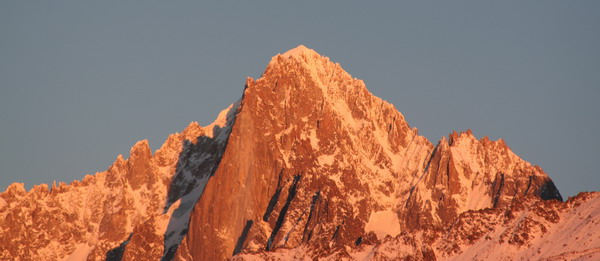
That night, we wandered around the town of Chamonix. Yes, that is hot iron she is using.
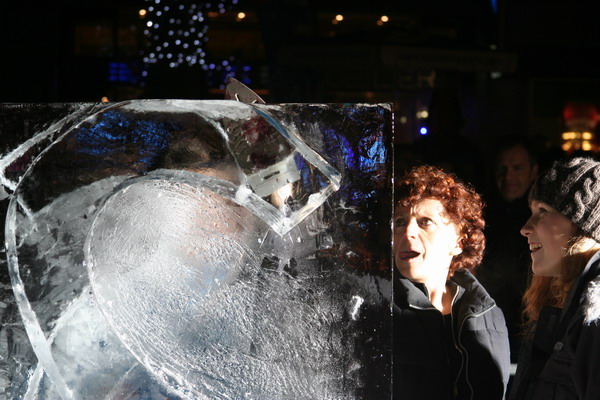
Next day, we decided that snow shoeing was so much fun that we hired a guide to lead us across one of the high mountain glaciers. To get there though, we had to pass underneath the mountain and into Italy. Along with 3 of our friends and our guide we hopped on a gondola and took the easy way up the mountain to about 3,500 meters (11,500 ft).
Here are a few of the views from our trip across the glacier.
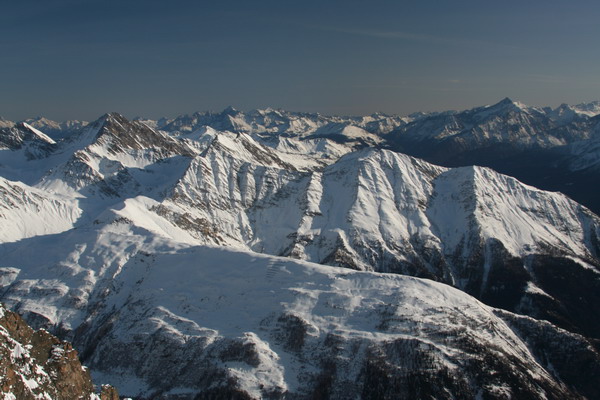
This is my favorite view of Mont Blanc.
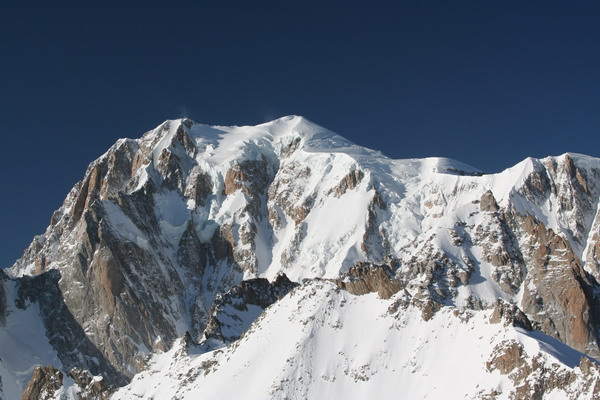
This is our fearless guide, Patrice. He has been guiding people on Mont Blanc for 36 years. Although he prefers rock climbing, he has made the ascent to the Mont Blanc massif more than 25 times. This is the mountain that began the modern age of mountaineering.
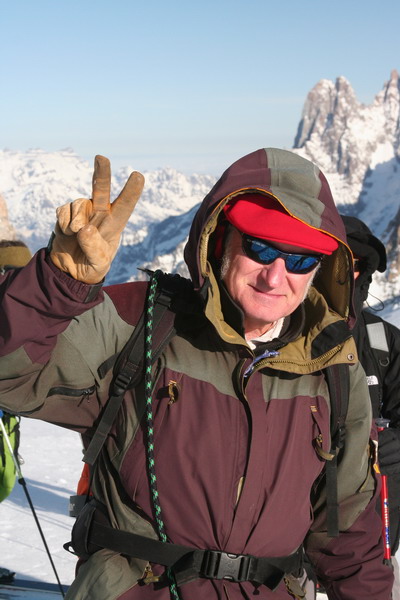
Here are three random facts about Mont Blanc thanks to Wikipedia:
– It was first ascended in 1786 by Jacques Balmat and Dr. Michel
Paccard
– Nearly 20,000 people ascend to the summit each year, even though
it is a technical ascent and requires a fair about of skill to
successfully reach the peak.
– Future President Theodore Roosevelt led an expedition and
reached the peak on his honeymoon in 1886.
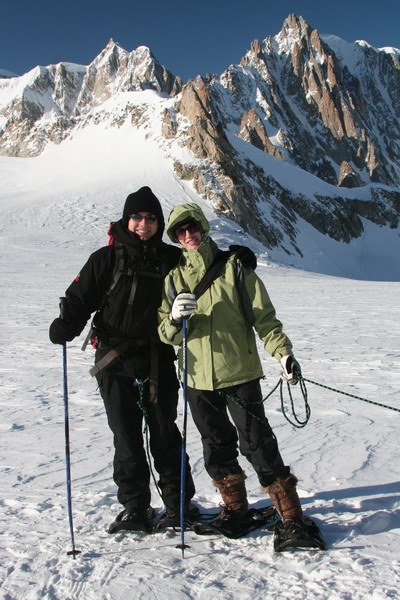
Although it was fairly safe to cross the glacier, we were crossing the valley on top of nearly 200 meters of ice and 2-3 meters of snow.
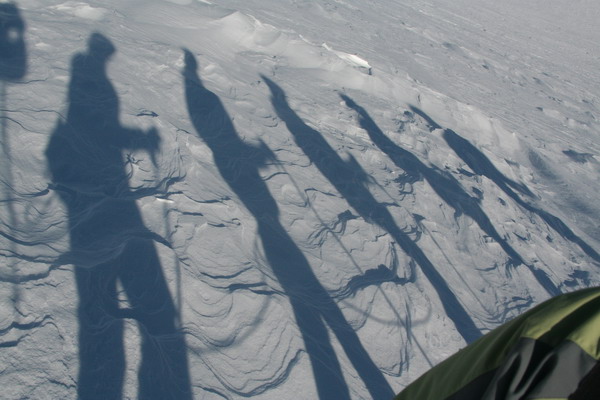
The far ridge of the mountain is the border between France and Italy. So, Patrice’s hand is in both countries.
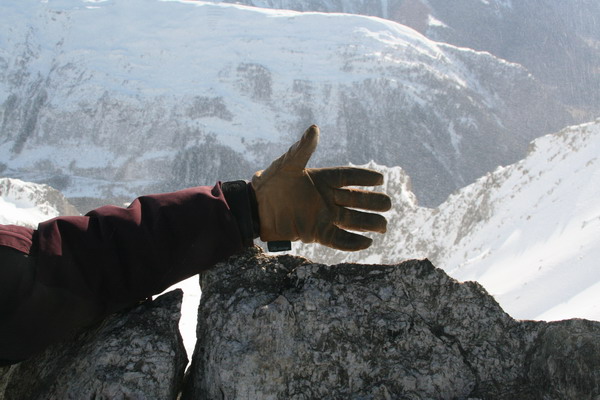
We stopped at the base of this peak for lunch.
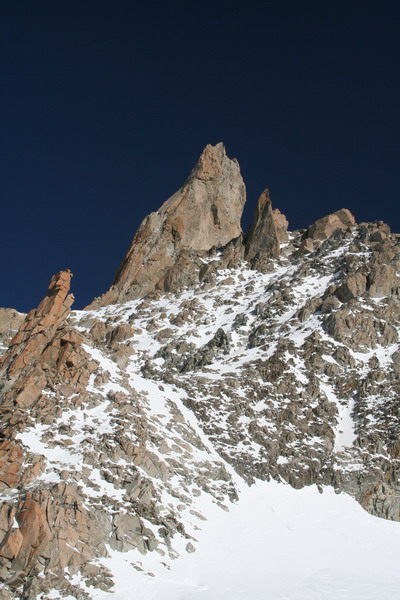
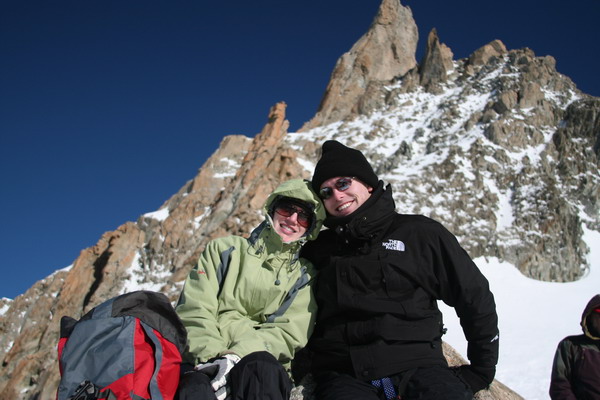
Here is Melissa enjoying her lunch.
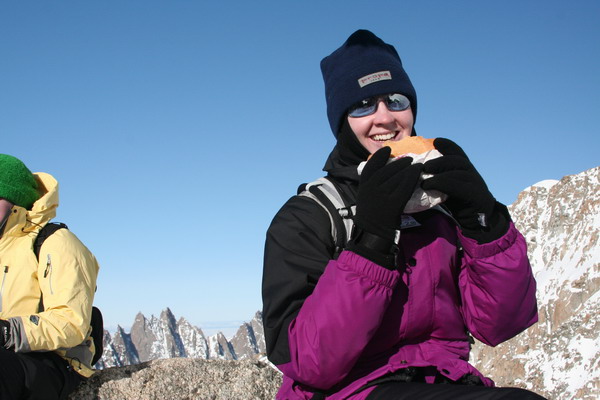
Ravi and Katie made a very cute mountain couple.
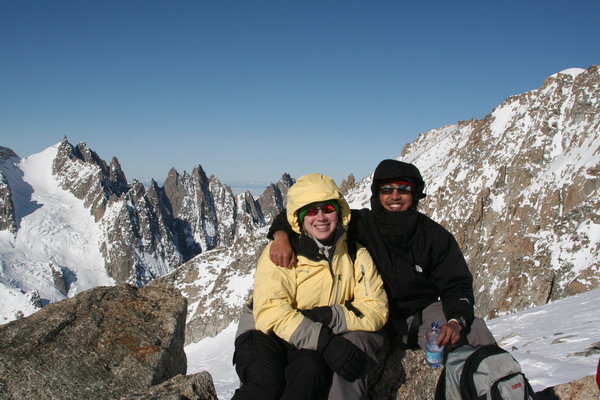
Here we are trekking back across the glacier.
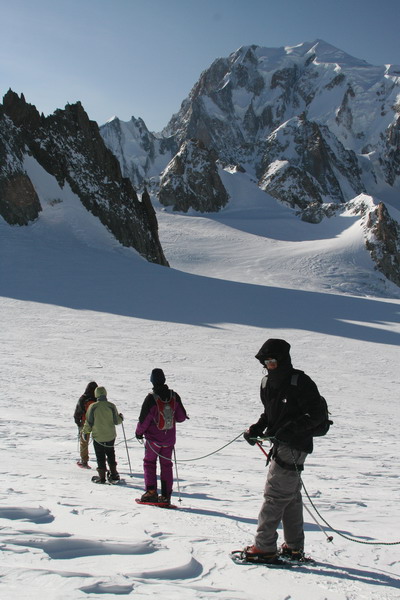
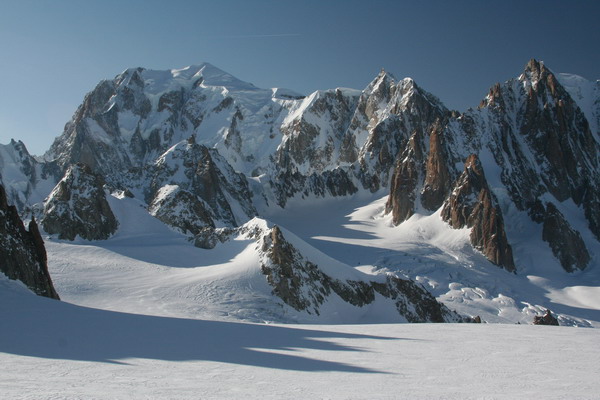
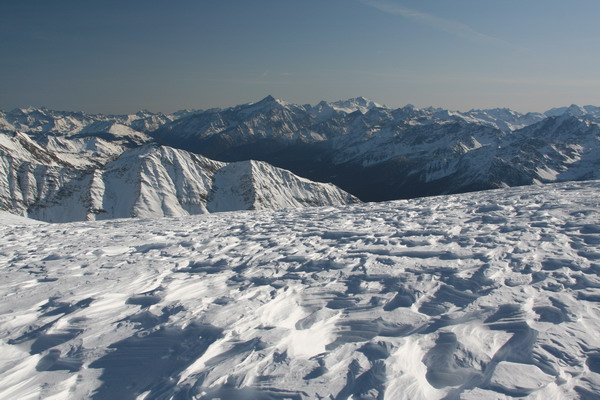
This is the “after” picture as we packed the gear up to head back down.
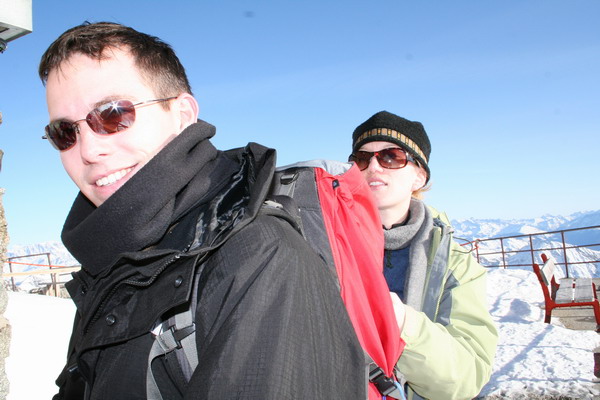
Katie caught me doing my thing… 🙂
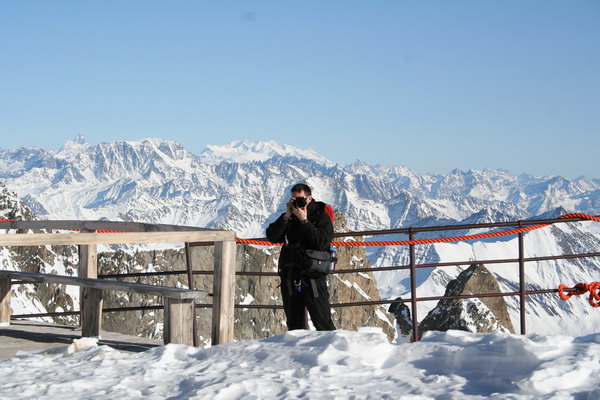
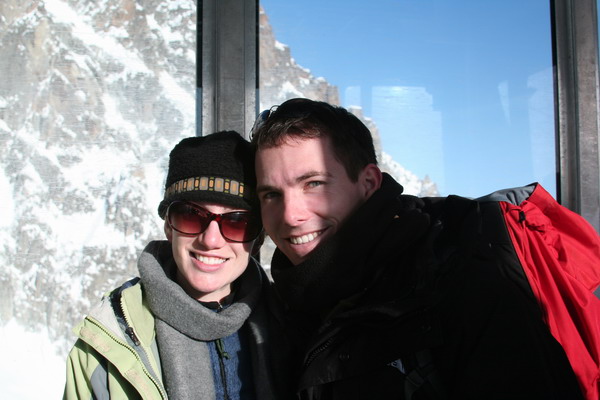
Back down at the bottom, we felt compelled to pop into the Italian diner. Some of us had espresso, but for us non-coffee drinkers, it was incredibly thick hot chocolate. Actually, it is the only hot chocolate that I’ve added a packet of sugar to. Perhaps that’s because it was only semi-sweet chocolate or maybe it was just because I love sugar, who knows…
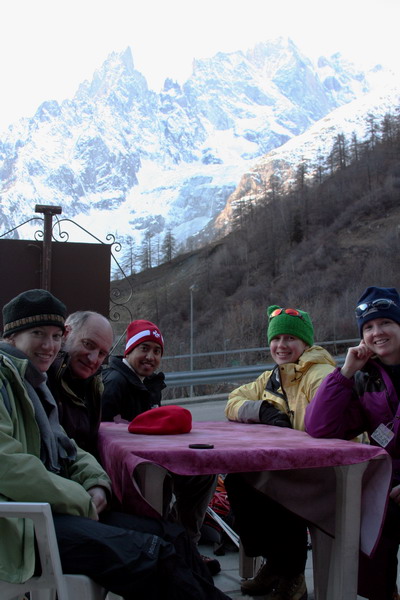
Anna and I really enjoyed climbing with all of them. It was a great way to get a taste of the high mountain. We plan to come back in the summer of 2008 to climb all the way to the top. Perhaps they will want to join us then.
Our last day in Chamonix was spent on yet another glacier, Le Mer de Glace (or Sea of Ice). This time, there was only a little snow on the ice, so we could actually explore the ice. At the top of a cog railway (again at about 1,800 meters). Unfortunately, it was a bit touristy, but interesting nonetheless.
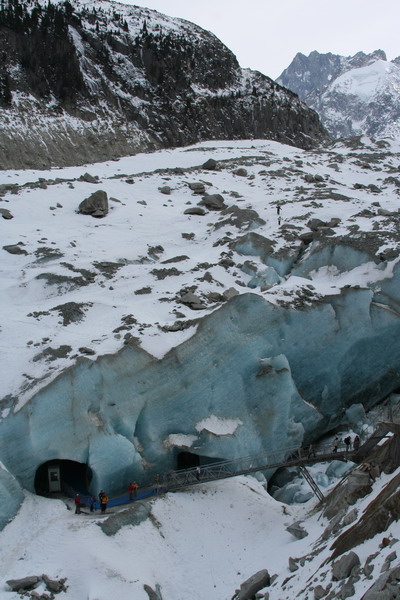
Here is the ice a little closer.
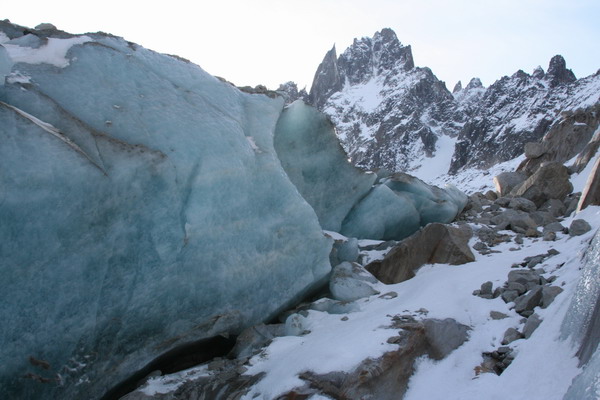
We explored the Ice Grotto. The ice is clear and absorbs all the red light which creates a brilliant blue hue.
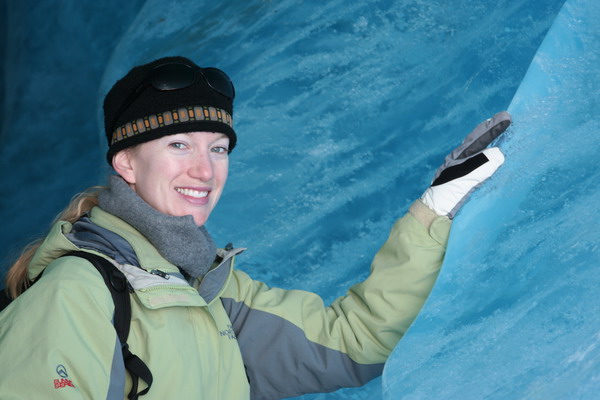
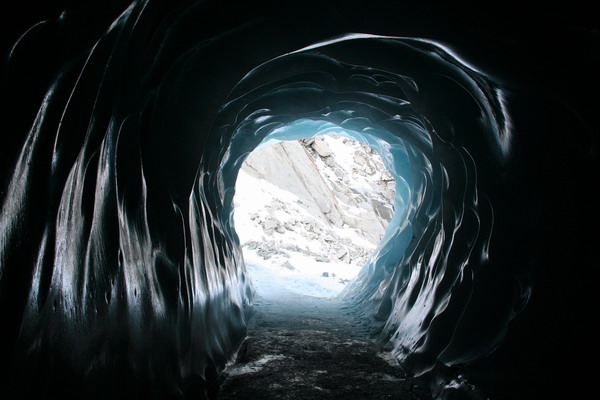
After we had our fill of the unique (albeit a little manufactured) ice grotto we headed out onto the ice. After what seemed like a long time, we reached another ice fall. Anna liked it so much, she gave it some love.
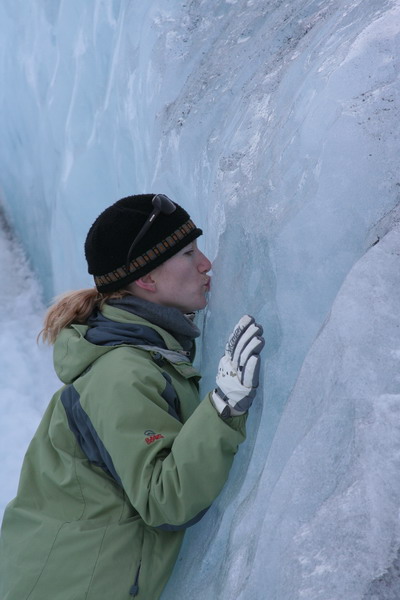
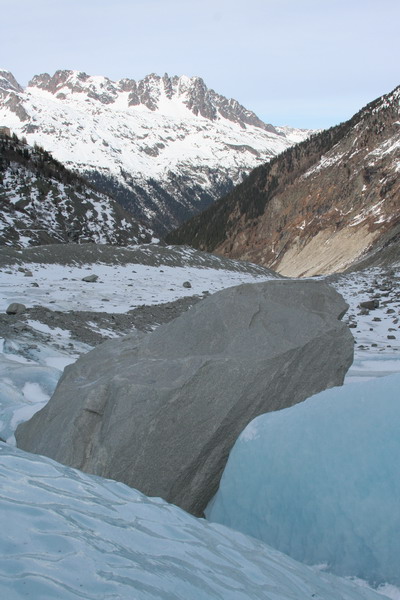
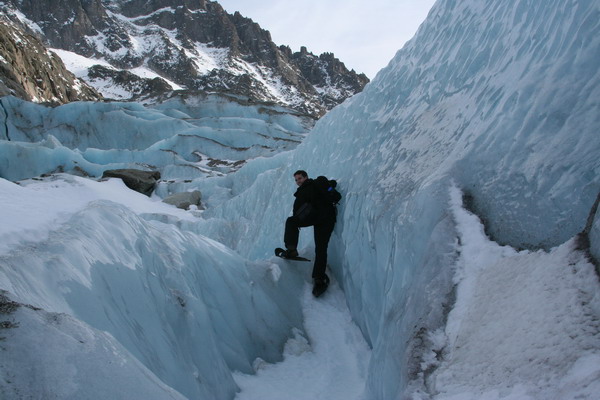
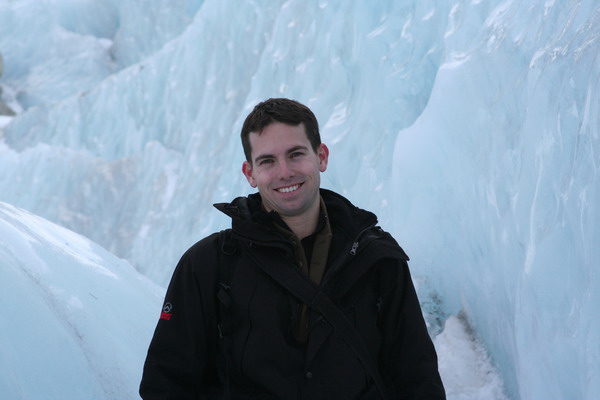
If you look closely, you can see little Anna hiking back over the glacier.
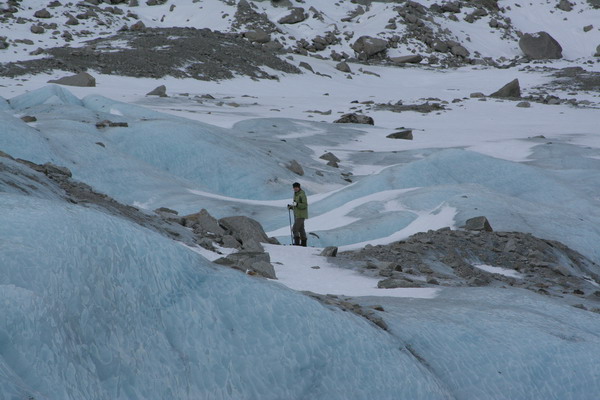
You can see how Le Mer de Glace slowly flows down from the heights of Mont Blanc into the Chamonix valley.
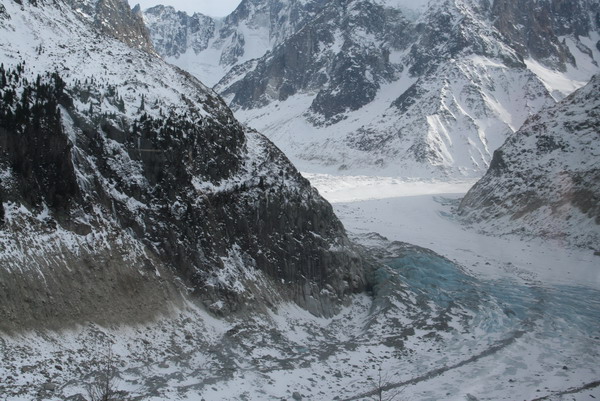
It was an amazing 4 days. We loved being back in the mountains and all the spectacular activities that are available. We can’t wait to go back to explore more of the Alps.
–Jim
Month: January 2007
New Year 2007 in Budapest!
This year to ring in the New Year, we went with a big group of friends to the historic Hungarian city of Budapest. Lonely Planet calls Budapest the Paris of Central Europe. I certainly agree with that description, there is culture, history, art and spectacular architecture.
The Danube River dissects the city and on one side is Buda with it’s castle district and the other is Pest with shopping and the impressive parliament building.
We began our exploration with a visit to one of the famous thermal baths. This one is in the Hotel Gellért. One of the more popular spots (especially for tourists). It was built in 1918 in an Art Nouveau style.
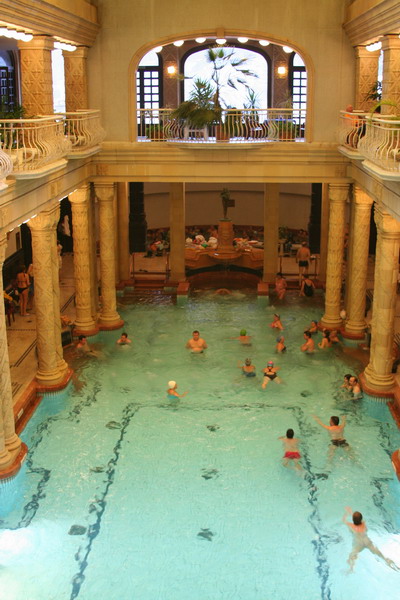
Here is the outside of the same hotel.
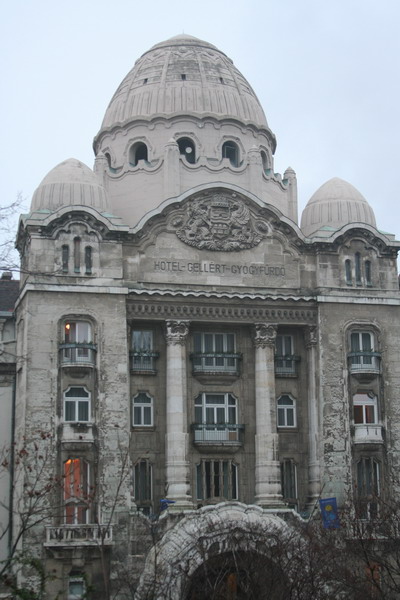
Just outside, there is a hill, over which this statue stands sentinel.
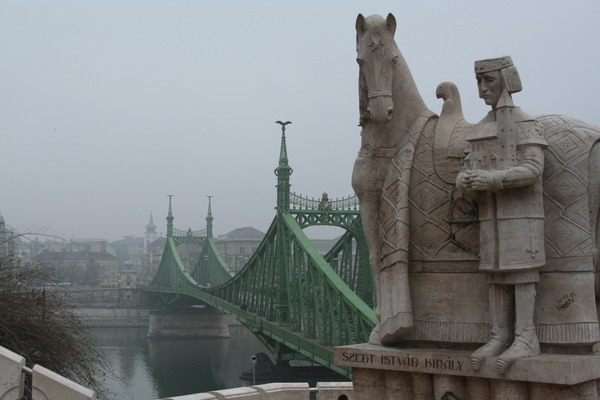
Here is a sampling of the city’s wonderful architecture. First, is one of the city’s main bridges.
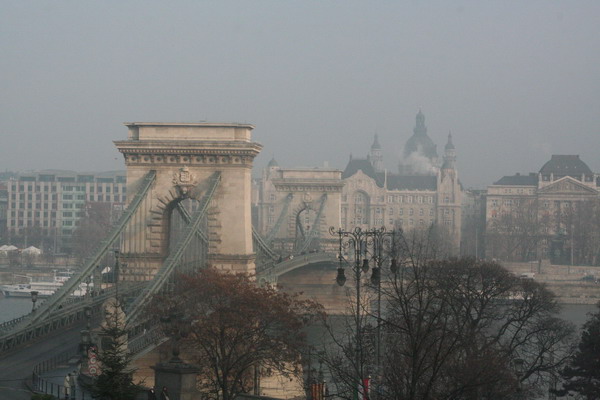
Next is the gargantuan parliament building.
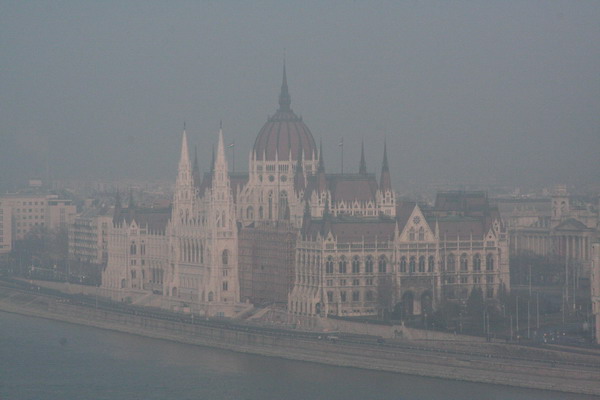
St. Mathias Church dominates the skyline on the Buda side of the Danube.
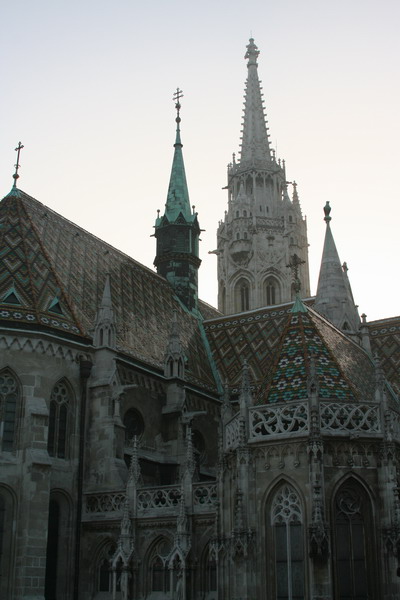
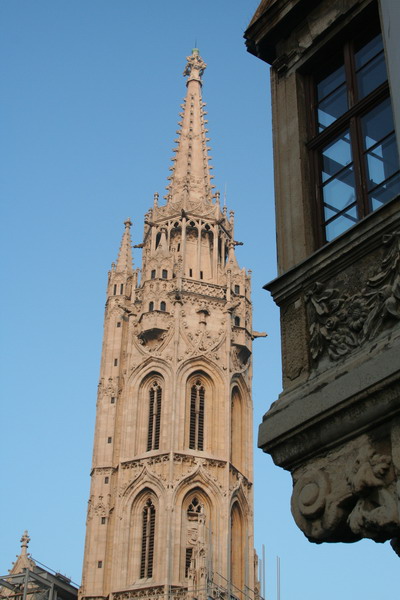
This is King St. Stephen, who was the first king of Hungary and ruled 997 – 1038 AD. He fought against pagan forces to control the country and with his victory assured Christianity’s dominance. He planned to abdicate to his beloved son and spend the rest of his life devoted to the church, but his son died unexpectedly in a hunting accident in 1031. Upon his death in 1038, his people mourned him for three years. He is still revered as the father of the country and his image is on the 10,000 Forint currency (roughly equivalent to $50 in 2006) and his feast is celebrated on August 20th and is one of the largest holidays in Hungary.
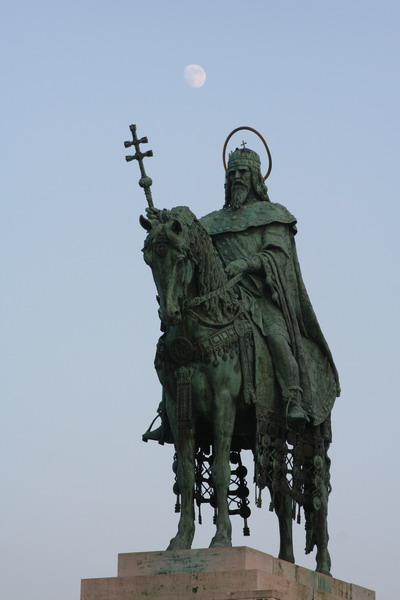
The statue of the king stands in front of the Fisherman’s Bastion. It’s a fairly modern building (built between 1895 and 1902).
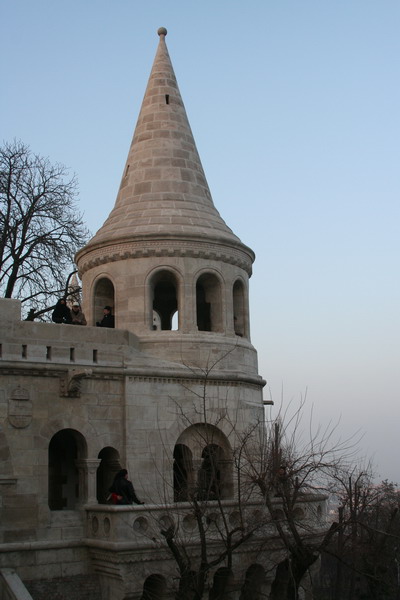
A view of the parliament building through the arches in Fisherman’s Bastion.
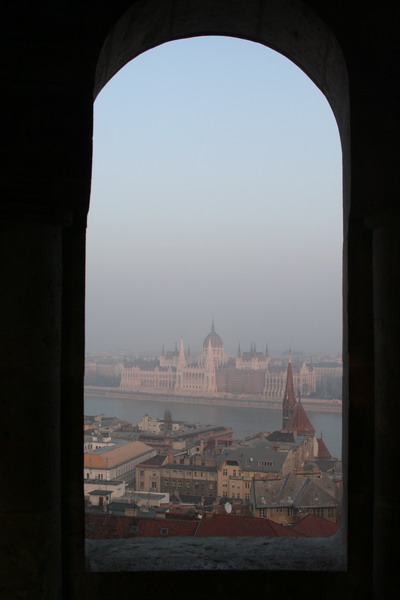
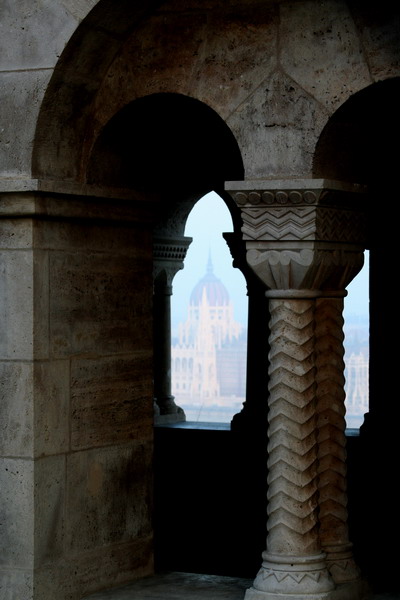
As it grew colder at nightfall a soft blanket of fog fell over the city and made for nebulous images. These next few are from the Buda Castle Quarter. We also toured the Labyrinth beneath the quarter (which is one of the UNESCO World Heritage Sites).
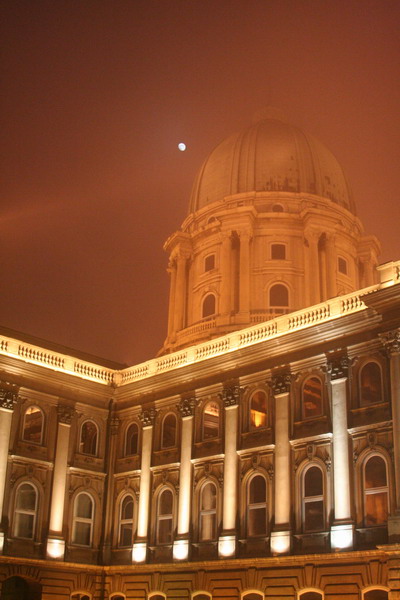
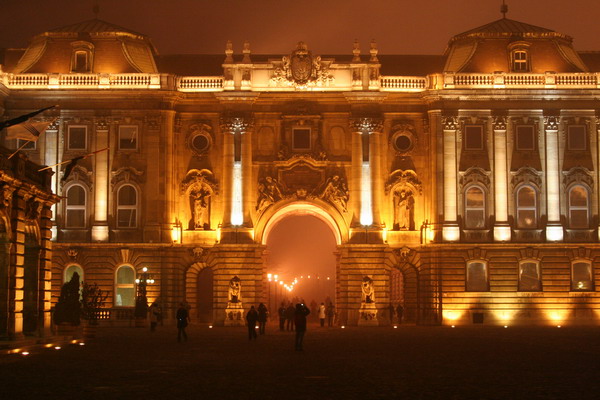
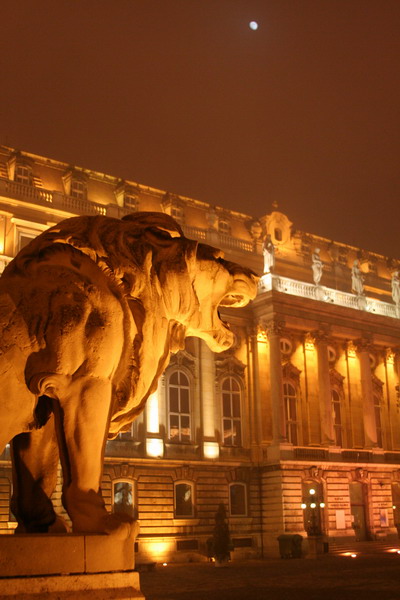
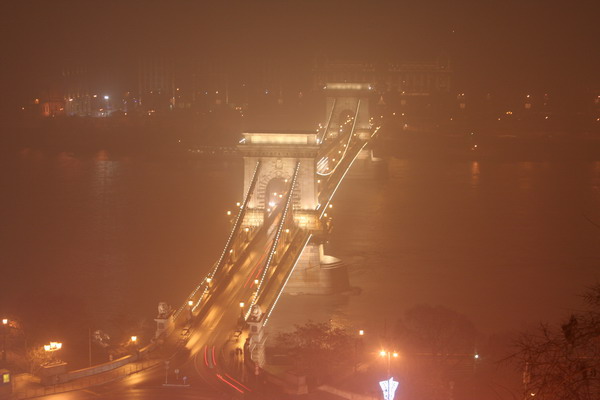
St Matthias Church and Fisherman’s Bastion.
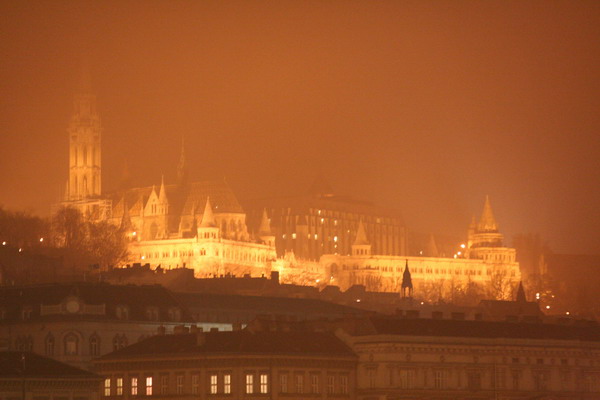
More sites of the city.
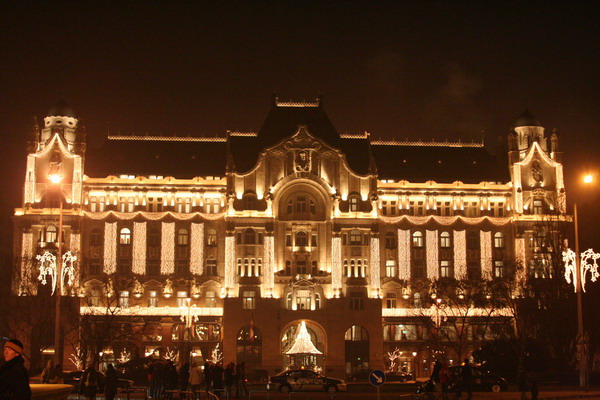
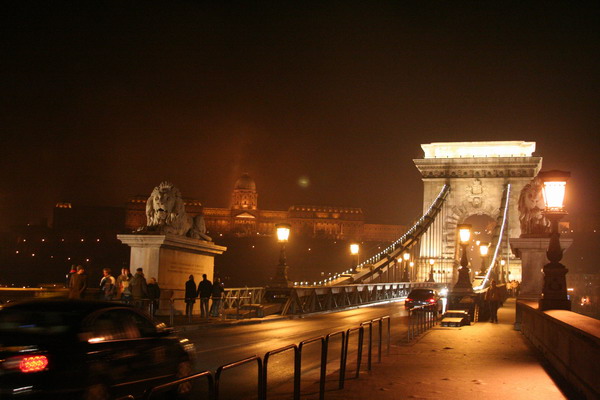
We gathered with a group of people on the bridge to ring in the New Year. If it hadn’t been foggy, we would have seen the large fireworks display. Tons of smaller parties were simultaneously going on in this city of nearly two million people. In fact, they had a lovely Christmas Market and three different concert stages set up (at least that we saw).
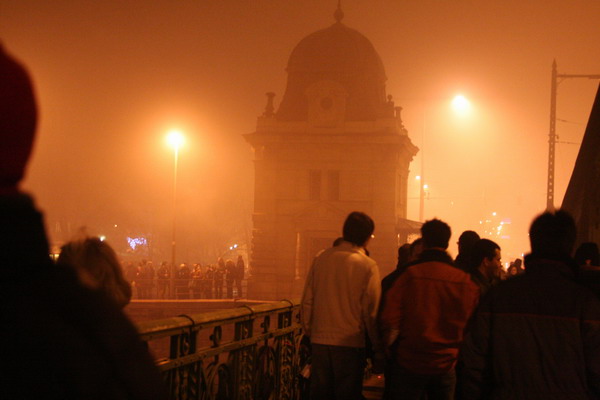
Although there were over 20 of us on this trip, we split up into smaller manageable groups. Here are the girls with me and Ken.
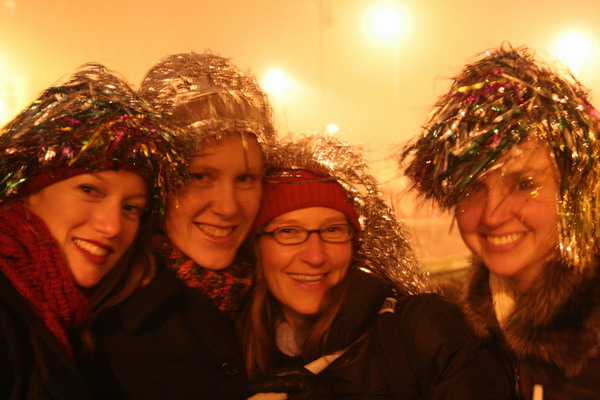
Happy New Year!
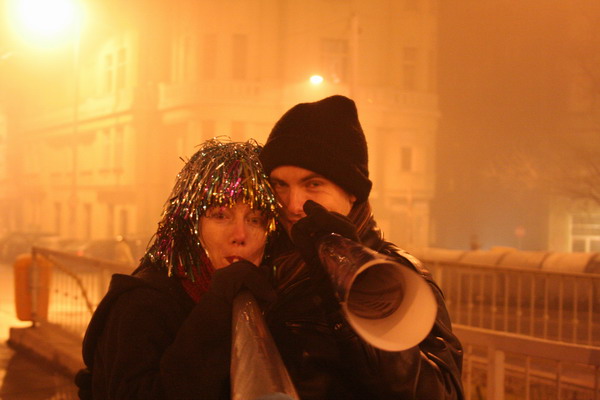
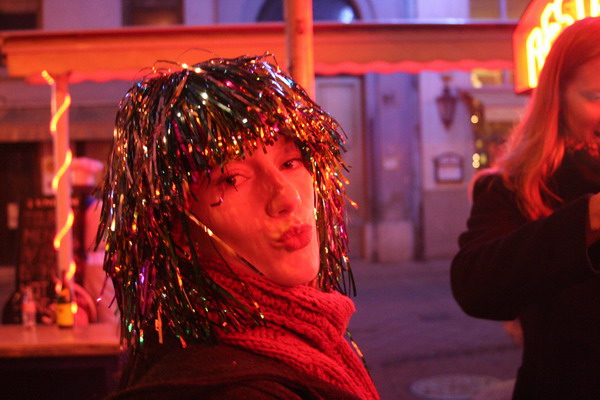
Sparklers are always fun to play with.

Here we all are walking back through the streets of Budapest.
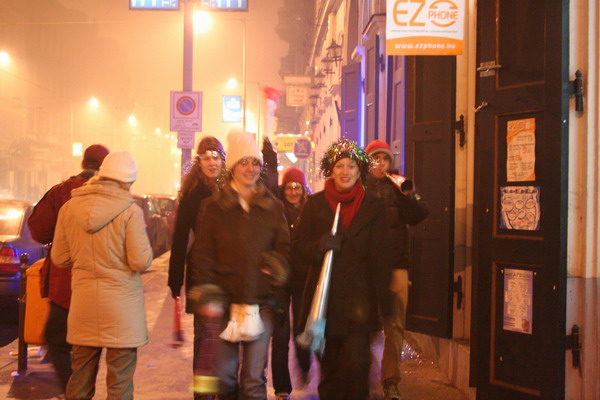
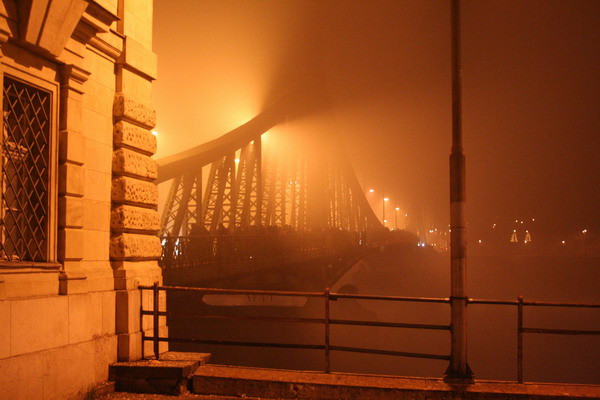
So, that was our little trip to Hungary. It’s a fascinating country and we both loved our experience there.
So, until the next adventure…
–Jim
Anniversary in Brussels
WARNING, this post has become a bit long … sorry if this page takes forever to load.
This year, for our anniversary trip, we decided to go to Bruxelle (or Brussels in English), Belgium. It’s funny how each language calls locations something different. In addition to those to versions, there is also: Brüssel in German, Brussel in Dutch, and Bruselas in Spanish, just to name a few.
It was a beautiful trip and fortunately, it’s only a couple hours from our house, so we can go back again.
Of course, we had to try things like the chocolate, waffles and French Fries (yes, those are actually a Belgian creation). But, there were other things like the most beautiful square square we’ve seen yet and the sweeping plains of Waterloo where the seminal battle of the 19th century took place.
Here are some of the images from the trip. We started out in Le Grand Place, which was lit up for their Christmas Celebration. As you saw in our last entry, many places in Europe have these Christmas Markets, although none had this spectacular ambiance.
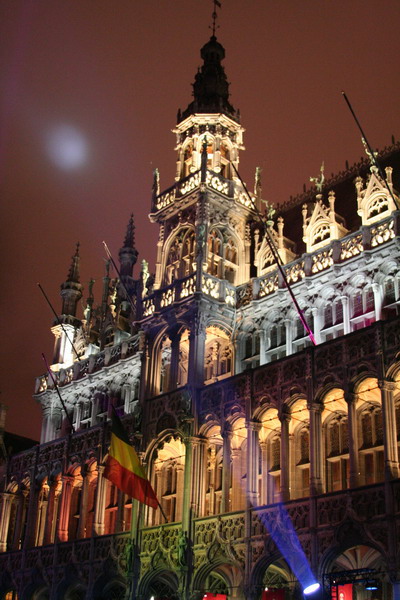
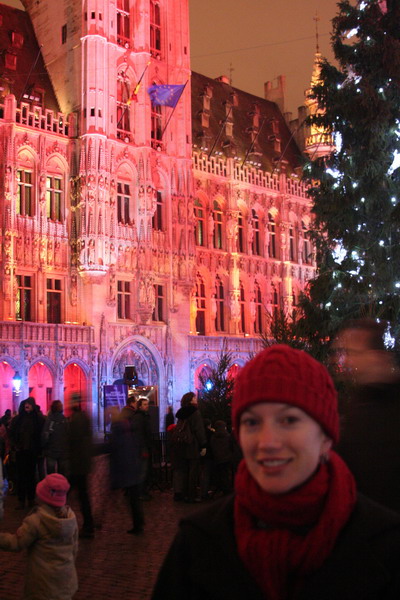
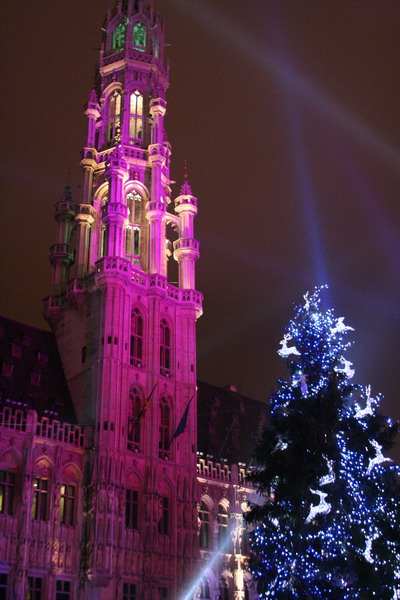
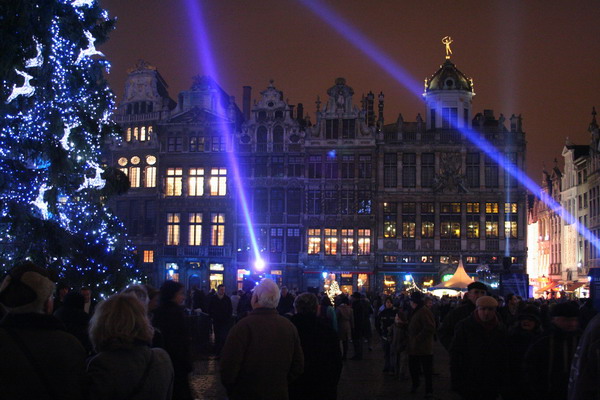
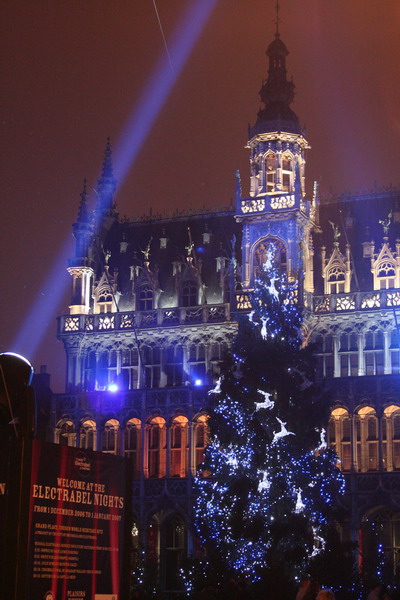
Many people say that Belgian Chocolate is the best in the world. Since I am not a true connoisseur, I can’t say if that’s true, but this place certainly qualifies as a contender. If you’re interested in sampling for yourself, they do offer online sales, but at 91 euro for about 32 pralines, it’s a bit pricey. However, they also supply the Belgian Royal family and it is President Bush’s favorite chocolate. So, I suppose that’s why they can justify such royal prices. http://www.marychoc.com/en/index.html
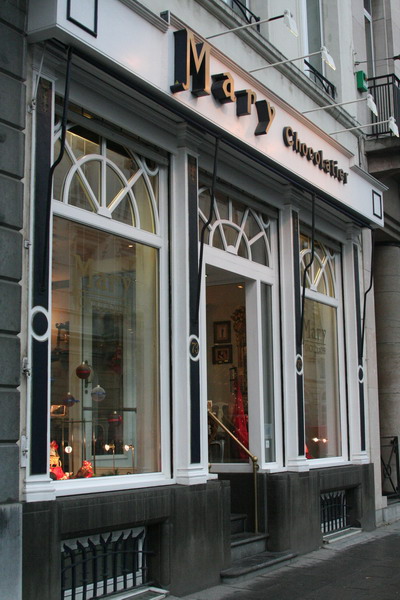
We also stopped by the Tomb of the Unknown Soldier.
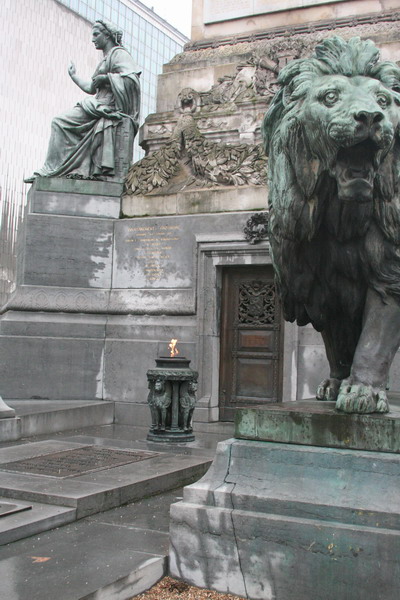
We visited a number of museums during our stay. This behemoth housed 5 different ones.
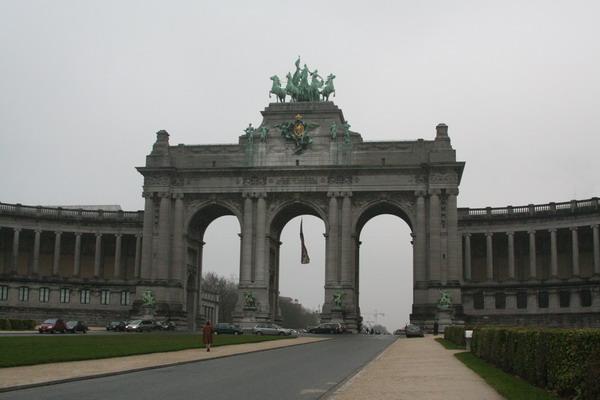
Inside, it was fascinating to see the large memorial exhibit to President Herbert Hoover. While in America he is largely (and unfairly) remembered for his “indifference” at the outset of the Great Depression, in Belgium, they hold him in high regard. This is because at the outset of World War I, he set aside his very lucrative career as a mining engineer to aid those in need. He organized the return of 120,000 Americans (tourists and businessmen) from Europe. Later, he personally oversaw the largest relief effort to date. Belgium was occupied by Germany and its food supply was in dire straits. He led the Committee for Relief in Belgium. This was a massive organization that was in effect it’s own republic. They had their own logistics system (railway, navy, and mills), and even their own flag (so not to be mistaken while at sea delivering food to the war’s victims). Even before the end of the war, he was an international hero. He later became the head of the American Food Administration (after the U.S. entered the war in 1917), then Secretary of Commerce in 1921, and finally elected President in 1928. He lost his re-election campaign to President Roosevelt in 1932, but stayed active in politics and also aided the recovery effort of Europe again after WWII as chairman of the Hoover Commission.
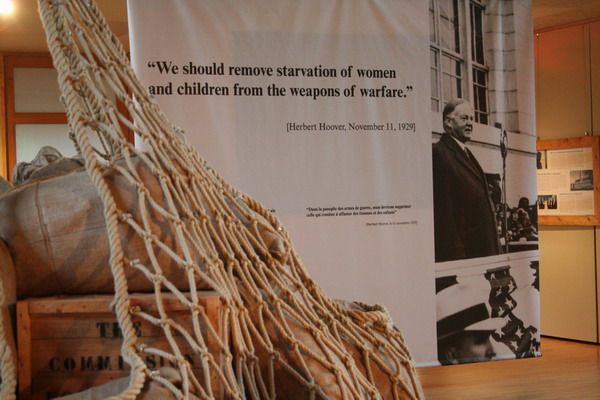
The museum also included a vast display on WWI (and slightly smaller ones on WWII and earlier wars). Here are some of the images.
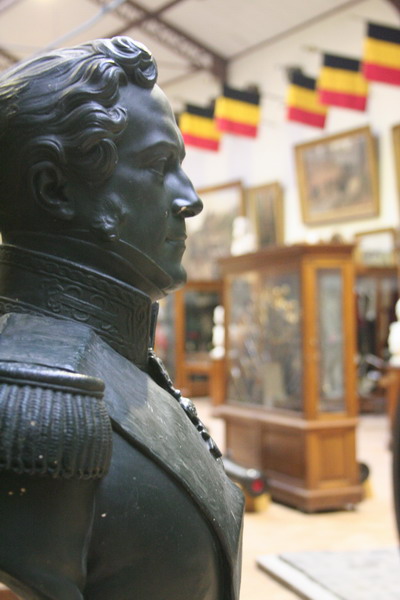
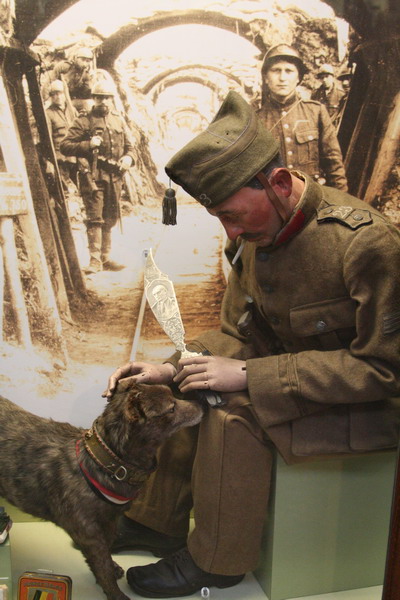
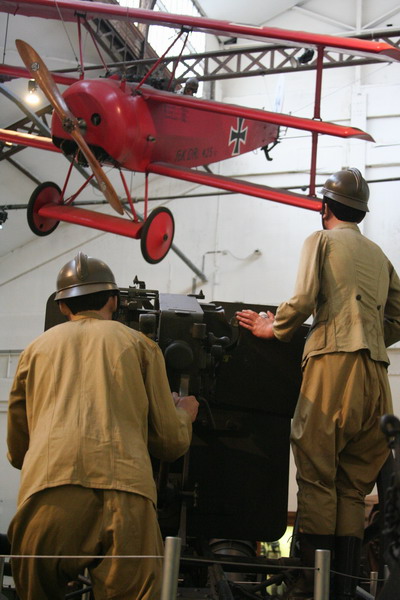
They even had a stuffed Homing Pigeon (many were used in WWI to send hundreds of microfilm messages back and forth).
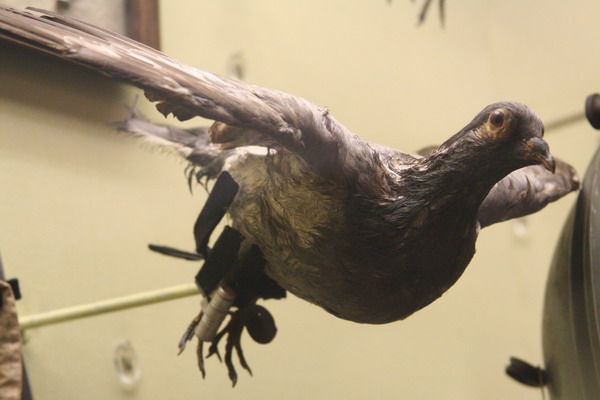
WWI was truly a global war and there were displays that illustrated the uniforms of other countries, such as colonial India, shown here:
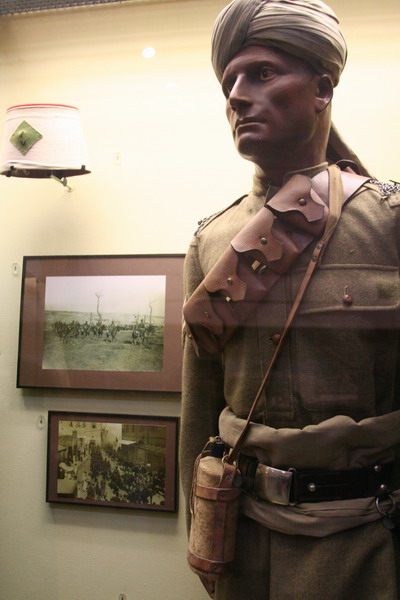
Or Australia here (which is officially still a part of the United Kingdom).
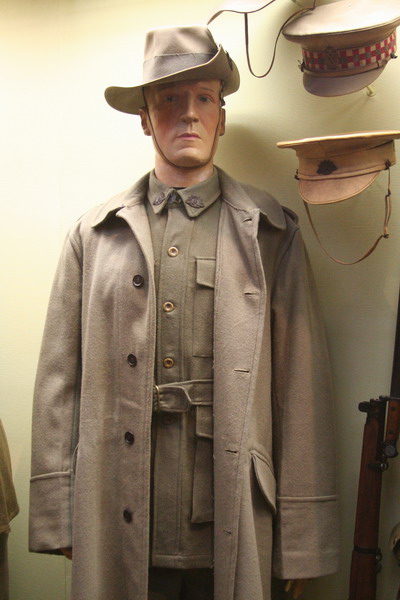
There was also a large aviation section. 🙂
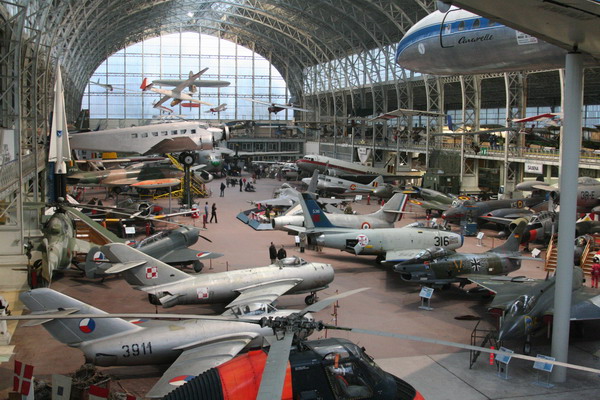
We traveled just outside the city to the small village of Waterloo. Here on June 17-18th, 1815, the allied armies of Britain, Prussia, Austria and others faced the French led by Napoleon in what was to be his final defeat. As a bit of background, this was basically Napoleon’s last stand to remain in power. The other powers in Europe had denounced him as an outlaw and intended to invade France with an overwhelming force to drive him out of power. To avert this, Napoleon attacked the allied force before they had a chance to assemble against him. He hoped to attack and defeat the Prussian and British forces separately, but was unable to do so decisively. So, 73,000 French troops met 67,000 allied forces at Waterloo. The result was a decisive coalition victory and Napoleon’s ultimate exile to St Helena where he died in 1821. The cost was very high with 25,000 French dead or wounded and 22,000 Allies dead or wounded. Although this happened nearly two centuries ago, visiting the battlefield was still a poignant experience.
Here is the Duke of Wellington, the man who was the overall commander of the Allied force at Waterloo and credited with the victory which shaped the rest of the 19th century.
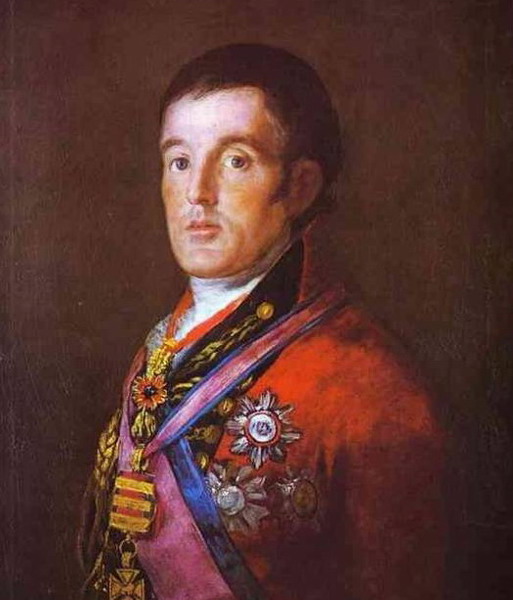
Here is a wax likeness of Napoleon Bonaparte as he looked in 1815.
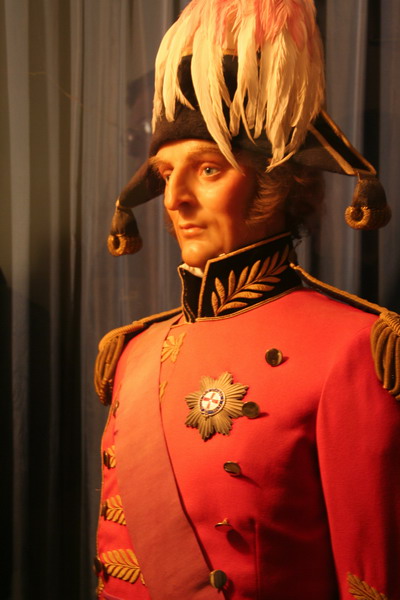
In 1820, the Dutch built a massive monument where the Price of Orange was probably wounded. The House of Orange and Queen Beatrix enjoy a very popular monarchy in the Netherlands today.
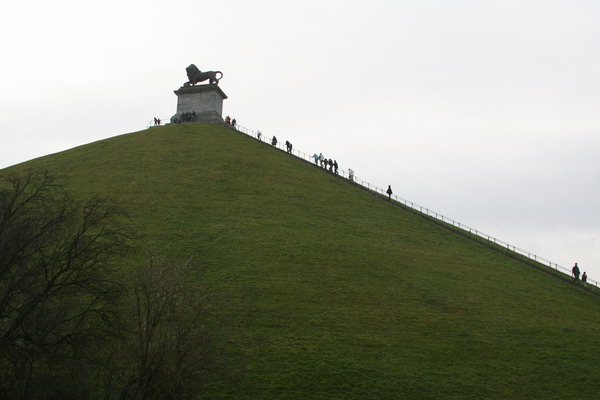
Here I am at the top of the of the Lion Monument.
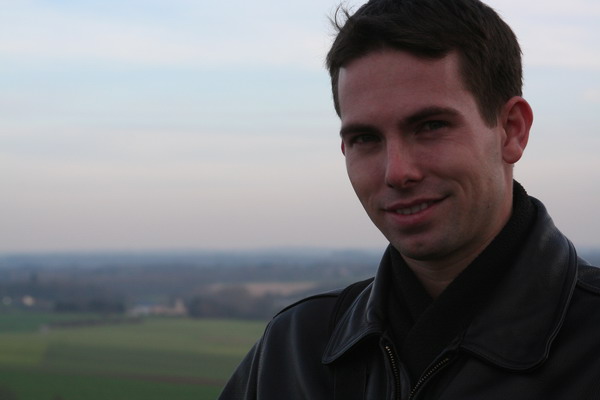
This is the main battlefield where the European powers of the 19th century met in battle.
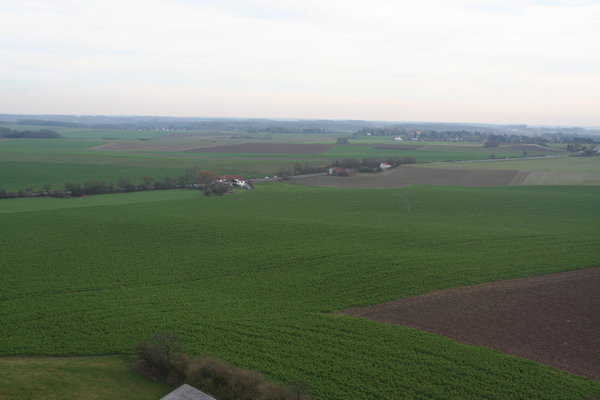
The museum there had a grisly display of the cost of war.
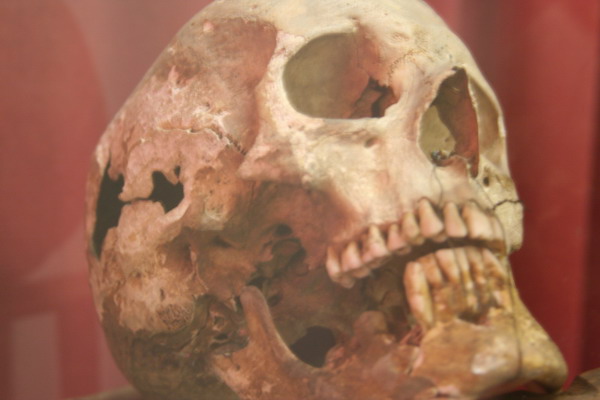
Also, there was a wax likeness of Napoleon’s face created just after he died in St Helena by his physician (wow, who does that??!)
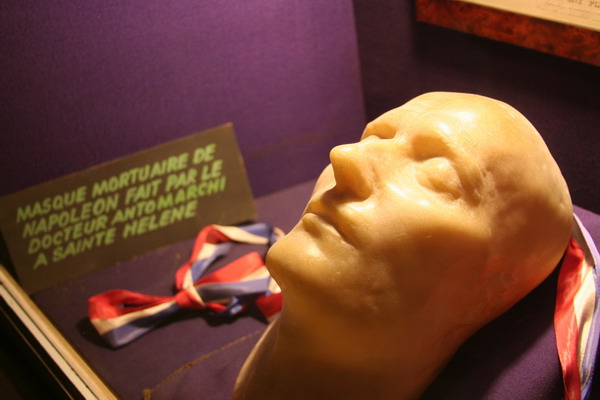
Here you can see the statue of Everard ‘t Serclaes. A 14th century hero. Whose gleaming torso nearly everyone rubs the length of for good luck.
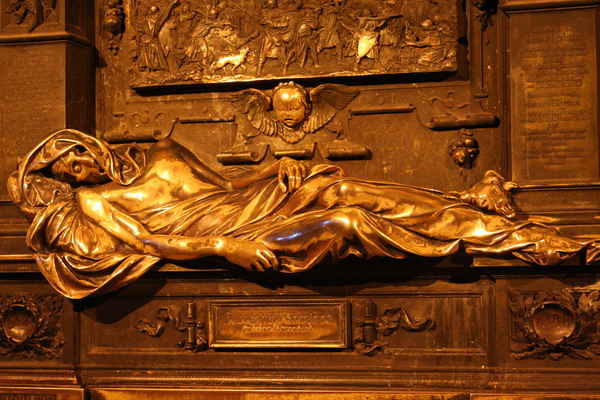
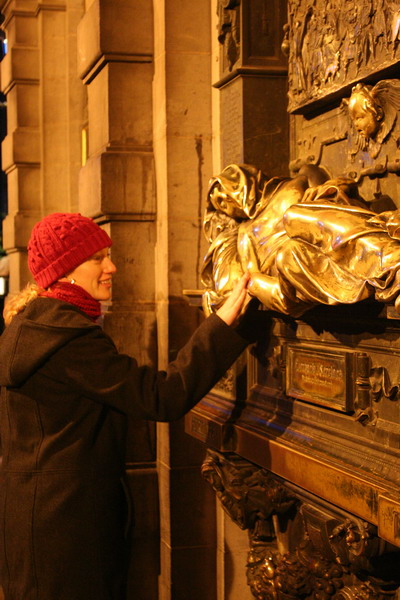
On a completely different note, let’s look at the national symbols of a few countries. The U.S. has the Statue of Liberty, Australia has the Sydney Opera House, France has the Eiffel Tower, Italy has the Tower of Pisa and Belgium has the Manneken Pis.
This national symbol is a very unimposing figure of a young boy urinating into a pool. There are several versions of this statue throughout the country and there are several versions of the story behind the statue. The first version is that a two-year old duke in 1142 was hung in a basket in a tree as his troops fought a battle to encourage them. During the battle, the young boy peed on the enemy and they eventually won the battle. The second is that during the 14th century Brussels was under siege and a young boy spied the enemy laying explosive charges on the city wall. He peed on the fuse to put it out and thus saved the city. I don’t know which (if either) is true, but the statue is a very interesting (if not humorous) national symbol. I think it speaks highly of a culture that is confident, ancient and not afraid to make a little fun of itself.
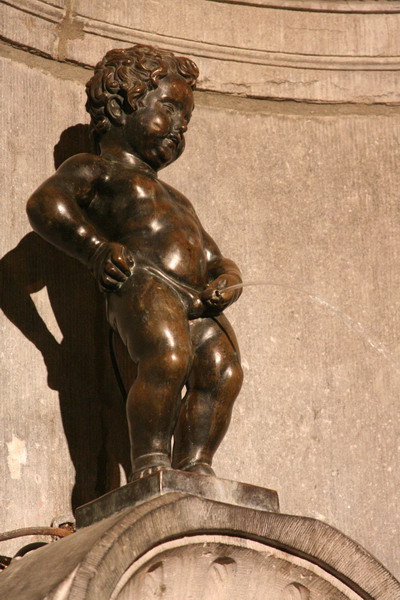
You can see it’s a but diminutive, so don’t be disappointed if you go see it…
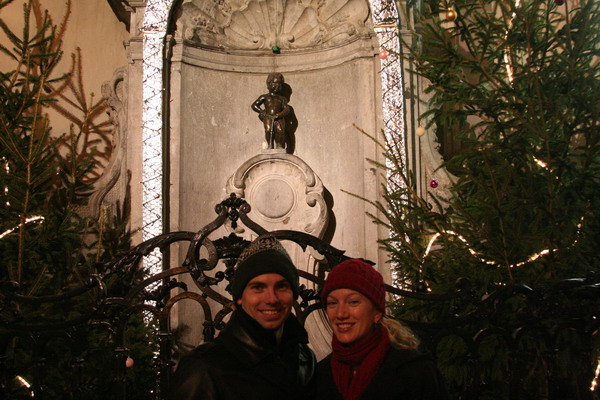
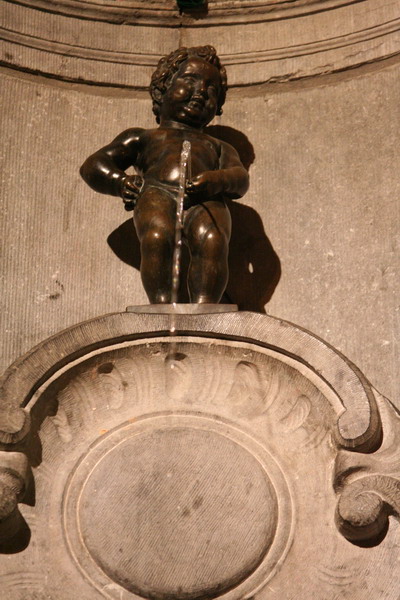
So, with that, our time in Belgium had come to a close. It was a fabulous way to spend our anniversary. Of course, immediately when we got home, we repacked our suitcase (we’ve learned to travel light) and headed out the door for New Year’s in Budapest. That post will follow shortly (hopefully).
Until then…
–Jim
